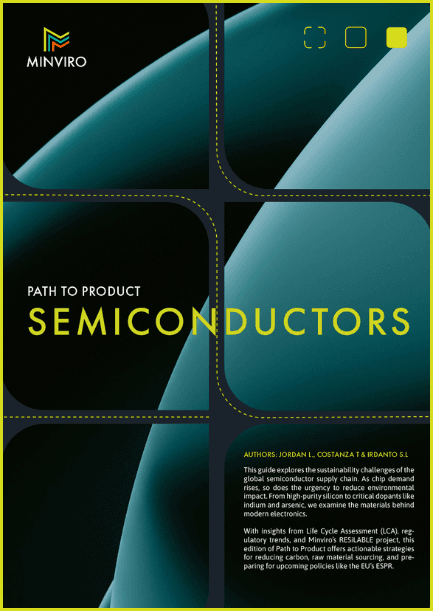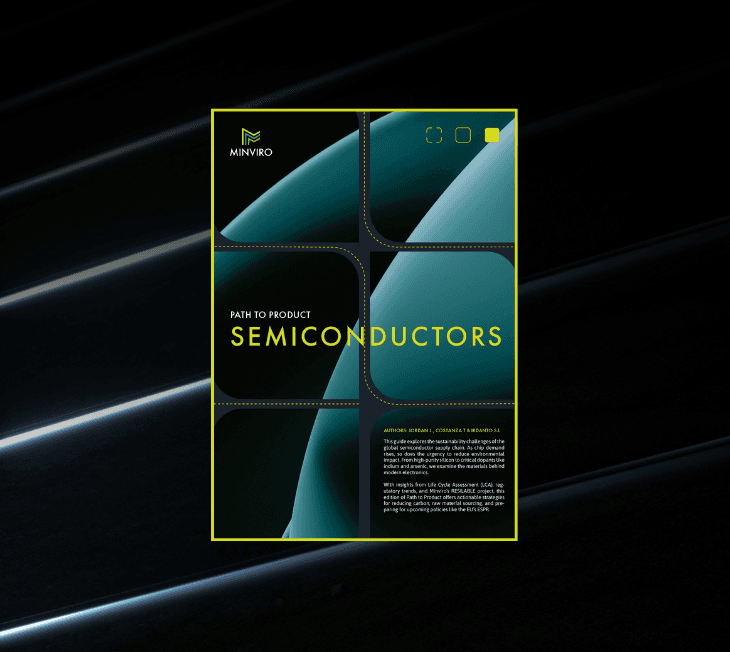- solutions
- industries
- about us
- resources
Client Resources
Path to Product: Sustainable & Compliant Semiconductor Supply Chains
By Jordan Lindsay, Costanza Tinari, Irdanto Saputra Lase
Cut carbon, secure critical inputs and meet ESPR & DPP rules. Minviro’s guide shows chip makers where the lifecycle impact hides, and how to reduce it.
Download
The outline
Why Chip Sustainability Now Determines Market Access & Margin
Unlock a data-driven pathway to lower carbon, secure critical inputs and satisfy new EU Ecodesign & Digital Product Passport rules. This semiconductor guide looks at 16 life-cycle impact categories, highlights seven high-risk elements (Si, Ga, Ge, Ta, Cu, As, In) and benchmarks process-level abatement options.
Whether you’re a chip manufacturer, electronics OEM or sustainability lead, Path to Product – Semiconductors provides a clear pathway from baseline compliance to long-term environmental leadership. Learn how an ISO-aligned Life-Cycle Assessment framework can cut process emissions, secure high-risk materials and prepare your supply chain for upcoming requirements.
Lowering Carbon in Energy-Intensive Fabrication Stages
Photolithography, plasma etching and other fluorinated-gas steps dominate a semiconductor’s Scope 3 footprint. Minviro’s analysis shows that grid mix and tool choice can multiply emissions, making renewable electricity procurement and gas-abatement systems the fastest route to measurable carbon reduction.
Critical Materials: Mapping Seven High-Risk Elements
Silicon, gallium, germanium, tantalum, copper, arsenic and indium each carry distinct environmental loads and supply-chain exposures, 98 % of refined gallium, for example, comes from a single country. The guide scores every element on carbon intensity, recycling potential and geopolitical risk, then outlines practical sourcing mitigations.
Lifecycle Assessment Across 16 Environmental Indicators
Beyond CO₂, Minviro’s ISO-aligned LCA quantifies water stress, ecotoxicity, metal depletion and 13 other categories. This holistic view pinpoints true hotspots from quartz purification through end-of-life, enabling engineering teams to model improvements before committing capital.
Process Optimisations That Can Halve Emissions
Dry plasma etching, selective deposition, closed-loop gas recycling, point-of-use scrubbers and HVAC heat-recovery are documented to cut manufacturing emissions by up to ~50 % when combined with low-carbon electricity. The PDF provides performance data and implementation considerations for each option.
Circularity: Wafer Reclaim & Cross-Sector Silicon Reuse
Off-cut silicon that once went to landfill can feed solar panels, while silicon recovered from end-of-life PV modules can re-enter electronics after refinement. Add wafer-reclaim programs, closed-loop water and gas systems, and you reduce virgin demand, waste and operating cost simultaneously.
ESPR & Digital Product Passport Compliance Timeline
Delegated acts under the EU Ecodesign for Sustainable Products Regulation begin landing in 2025–26. Verified Scope 3 metrics, material provenance and recycling data will be mandatory for semiconductor components entering the European market. The guide details required data points and suggested readiness steps.
download
Get access today
Fill in the form below
Download
